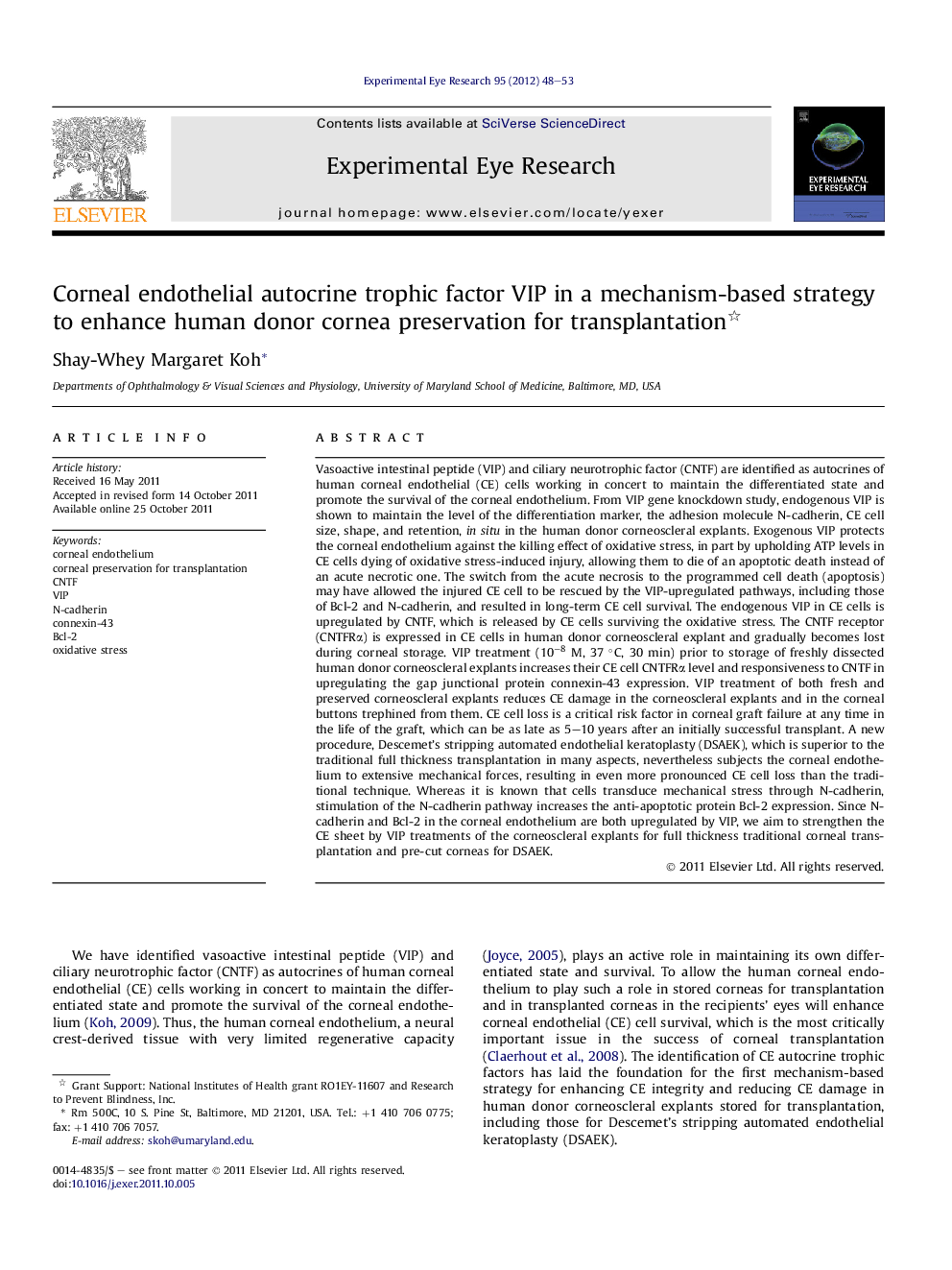| کد مقاله | کد نشریه | سال انتشار | مقاله انگلیسی | نسخه تمام متن |
|---|---|---|---|---|
| 4011442 | 1261145 | 2012 | 6 صفحه PDF | دانلود رایگان |

Vasoactive intestinal peptide (VIP) and ciliary neurotrophic factor (CNTF) are identified as autocrines of human corneal endothelial (CE) cells working in concert to maintain the differentiated state and promote the survival of the corneal endothelium. From VIP gene knockdown study, endogenous VIP is shown to maintain the level of the differentiation marker, the adhesion molecule N-cadherin, CE cell size, shape, and retention, in situ in the human donor corneoscleral explants. Exogenous VIP protects the corneal endothelium against the killing effect of oxidative stress, in part by upholding ATP levels in CE cells dying of oxidative stress-induced injury, allowing them to die of an apoptotic death instead of an acute necrotic one. The switch from the acute necrosis to the programmed cell death (apoptosis) may have allowed the injured CE cell to be rescued by the VIP-upregulated pathways, including those of Bcl-2 and N-cadherin, and resulted in long-term CE cell survival. The endogenous VIP in CE cells is upregulated by CNTF, which is released by CE cells surviving the oxidative stress. The CNTF receptor (CNTFRα) is expressed in CE cells in human donor corneoscleral explant and gradually becomes lost during corneal storage. VIP treatment (10−8 M, 37 °C, 30 min) prior to storage of freshly dissected human donor corneoscleral explants increases their CE cell CNTFRα level and responsiveness to CNTF in upregulating the gap junctional protein connexin-43 expression. VIP treatment of both fresh and preserved corneoscleral explants reduces CE damage in the corneoscleral explants and in the corneal buttons trephined from them. CE cell loss is a critical risk factor in corneal graft failure at any time in the life of the graft, which can be as late as 5–10 years after an initially successful transplant. A new procedure, Descemet’s stripping automated endothelial keratoplasty (DSAEK), which is superior to the traditional full thickness transplantation in many aspects, nevertheless subjects the corneal endothelium to extensive mechanical forces, resulting in even more pronounced CE cell loss than the traditional technique. Whereas it is known that cells transduce mechanical stress through N-cadherin, stimulation of the N-cadherin pathway increases the anti-apoptotic protein Bcl-2 expression. Since N-cadherin and Bcl-2 in the corneal endothelium are both upregulated by VIP, we aim to strengthen the CE sheet by VIP treatments of the corneoscleral explants for full thickness traditional corneal transplantation and pre-cut corneas for DSAEK.
► Autocrine VIP ensures survival of the corneal endothelium in human donor corneas for transplantation.
► CNTF, also an autocrine, upregulates VIP, which prevents loss of CNTF receptor during corneal storage.
► In oxidative stress, VIP upholds ATP, increases N-cadherin, Bcl-2, and survival.
► VIP gene knockdown diminishes N-cadherin, hexagonal cells, and cell density.
► CNTF, released by corneal endothelium surviving oxidative stress, upregulates connexin-43.
Journal: Experimental Eye Research - Volume 95, Issue 1, February 2012, Pages 48–53